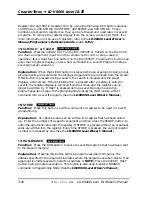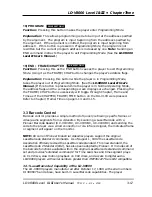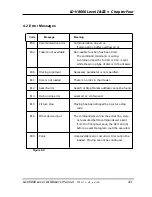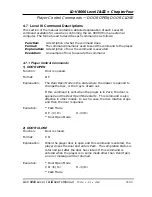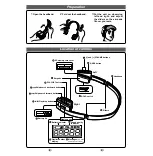
• When an error occurs, the subsequent commands in the current string will
not be executed.
• If a new command string is input before execution of a current string has
been completed, the remaining commands are cleared and execution is
cancelled. Thus, in order to cancel a currently executing string, simply
send the <C/R> without a preceding command.
• When the player is put into
Spin-Up Mode
,
Spin-Down Mode
or
Search Mode
,
by external commands SA, RJ or SE, subsequent commands issued will be
executed after the
Spin Up
,
Spin Down
or
Search Mode
cycle is finished, due
to the player’s communication protocol. If the user wants to check the
player’s status or set player control flags while the mode cycles are in
progress, a
Request Status
command (?P, ?D, etc.) or a command to set the
address flag (CH, FR, TM) can be sent. The player will process the
command, but won’t send a completion status.
4.6 Status Returns
The player can return codes to the computer indicating certain status conditions:
1)
Completion Message
The completion message used in Automatic Status is “R”.
R <C/R>
2)
Error Message
The error message is indicated by the letter “E” followed by a two-character error
number.
E N1 N2
<C/R>
The error message occurs when a command is non-executable and hinders continued
control. See list of the error messages,
Section 4.2 Error Messages
, page 4-3.
3)
Request Status Return
In response to a single request command, the status is displayed as the appropriate
character string with a termination code at the end. A termination code of either
<C/R> or <L/F> can be selected by using function switch S6.
NOTE:
The
termination code can be selected from among the On-Screen Switch Settings by
pressing the DISPLAY and Power-ON buttons simultaneously on the front panel of
the player. Press SCAN FORWARD to move to page 3 of the On-Screen Settings.
Then press STEP FORWARD twice to select the TxD Terminator, then Press STEP
REVERSE to toggle through the options. Press DISPLAY again to commit the
selection to the player’s memory.
LD-V8000 Level I & III • Chapter Four
LD-V8000 Level I & III User’s Manual
TP 113 v. 2.1 • 2/93
4-9


